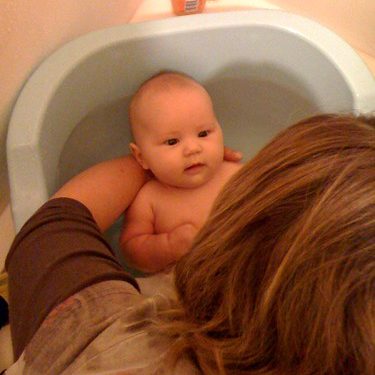Bath time can be one of the most cherished parts of your day with your baby—a time filled with splashes, giggles, and tender moments that strengthen your bond. However, for first-time parents, it can also feel overwhelming. What do you actually need for a safe and fun baby bath time? Are there particular products or practices that work best? In this comprehensive guide, we’ll dive into the essentials for making bath time a happy experience for both you and your little one, helping ensure that every bath is a time of comfort, safety, and connection.
1. Setting the Stage for Bath Time Comfort
One of the first things to consider when preparing for your baby’s bath is creating a warm and comfortable environment. Babies can get cold quickly, and making sure that the room is warm enough—ideally around 75°F (24°C)—is essential. This helps prevent the shock of moving from warm water to a cold room and ensures that the experience remains pleasant for your baby.
Another key element is having all your bath essentials gathered and within arm’s reach before you begin. This means you’ll never have to leave your baby unattended to fetch something, which is a crucial safety consideration. Essentials should include towels, washcloths, a gentle baby soap, and clean clothing or pajamas for after the bath.
2. Choosing the Right Baby Bath Tub
A good baby bath tub is a fundamental part of a safe and enjoyable bath time experience. Many different types of baby tubs are available, each with its own features and benefits. Some parents prefer a simple, traditional baby bathtub that can be placed in a larger tub or on a countertop, while others choose an inflatable or foldable tub for convenience and storage purposes.
For newborns, a bath support or sling that fits into the baby tub can be incredibly helpful in keeping the baby steady and secure. This not only helps prevent slips but also allows you to have both hands free for washing and playing with your baby. A tub with a non-slip surface is ideal, and it’s always a good idea to use a bath mat underneath if the tub is placed inside your regular bathtub to ensure stability.
3. Gentle Cleansers and Products
The delicate skin of a baby requires special care, and choosing the right soap and shampoo is crucial. Babies’ skin is much thinner than that of adults, making it more susceptible to irritation and dryness. Always opt for gentle, hypoallergenic cleansers that are free from harsh chemicals, artificial fragrances, and dyes. Many pediatricians recommend using a mild soap designed specifically for babies, which tends to be free from irritants.
Using too much soap can strip a baby’s skin of its natural oils, so remember that a little goes a long way. Most babies don’t need to be soaped up from head to toe every day—a gentle rinse is often enough, especially for younger infants. Consider incorporating a mild baby shampoo that’s designed to be tear-free so your baby stays comfortable if some of it inadvertently gets into their eyes.
4. Soft Washcloths and Bath Toys
A soft washcloth is an important tool for cleaning your baby’s skin. A small, gentle washcloth can help you clean between the folds of your baby’s skin without causing irritation. Using a separate washcloth for the face can also help avoid cross-contamination.
While washing your baby is obviously necessary, bath time can also be a time for play and discovery. As your baby gets older and more comfortable in the water, adding a few bath toys can make the experience more enjoyable. Simple floating toys, like rubber ducks or small cups, can help develop your baby’s motor skills while providing entertainment. Always choose toys that are free from harmful chemicals like BPA and ensure they can be thoroughly cleaned to avoid mold buildup.
5. Towels and After-Bath Care
Once bath time is over, you’ll want to wrap your baby in a warm, soft towel. Hooded towels are a popular choice for babies, as they help keep the head warm while also being the perfect size for swaddling your baby. Babies lose a lot of heat through their heads, so the hood helps keep them cozy right after their bath.
After you’ve gently patted your baby dry, it’s a good time to apply a gentle, baby-friendly moisturizer. Baby lotion or cream can help prevent dryness, particularly during the winter months when the air tends to be drier. Choose products free of artificial fragrances, as these can sometimes irritate sensitive skin.
6. Bath Time Safety Tips
Safety is one of the most important aspects of baby bath time. Never leave your baby unattended in the bath, even for a moment. Babies can slip under the water silently and in just a matter of seconds. To avoid any risks, always keep one hand on your baby and, if you need to grab something, take your baby out of the tub first.
The water temperature should be comfortably warm—not too hot and not too cold. A bath thermometer can be very helpful, and the ideal water temperature for a baby bath is around 98°F (37°C). Always test the water with your wrist or elbow before placing your baby in the tub. Remember that babies’ skin is much more sensitive than adult skin, and what feels comfortable to you may still be too warm for your baby.
Also, avoid filling the tub too much. A few inches of water is more than enough for a safe and comfortable bath. Babies do not need to be fully submerged; instead, use a small cup to gently pour water over their bodies to keep them warm.
7. Creating a Calm and Relaxing Atmosphere
Bath time can be a wonderful way to wind down after a busy day, creating a calming routine that helps your baby prepare for sleep. Keeping a calm atmosphere—using a soft voice, gentle movements, and warm water—can help relax your baby and build a positive association with the bath. Some parents find that playing soft music or singing lullabies during bath time helps soothe their baby, making it a more enjoyable experience for everyone involved.
When possible, try to bathe your baby at a consistent time each day. Consistency helps establish a routine, and many parents find that an evening bath is a great way to transition into bedtime. The warm water, gentle massage, and calming environment can be the perfect recipe for a sleepy baby.
8. How Often Should You Bathe Your Baby?
Many new parents wonder how often their baby actually needs a bath. The truth is, newborns don’t need to be bathed every day. Three times a week is usually sufficient, as over-bathing can lead to dry skin. In between baths, a quick wipe-down with a damp washcloth, especially in areas like the neck, hands, and diaper region, will help keep your baby clean.
As your baby grows and becomes more active, you may need to increase the frequency of baths, especially when they start crawling and exploring. However, even then, daily baths are not strictly necessary unless your baby genuinely enjoys them and they’re part of a bedtime routine.













